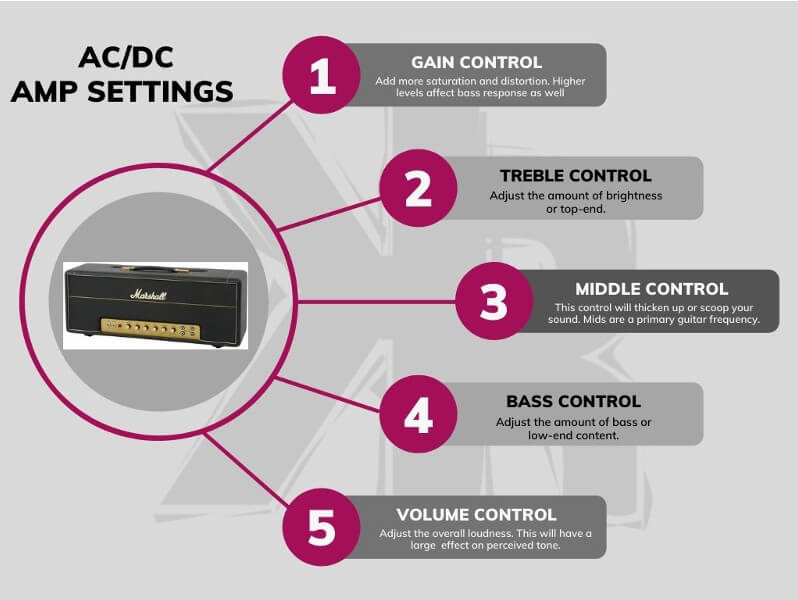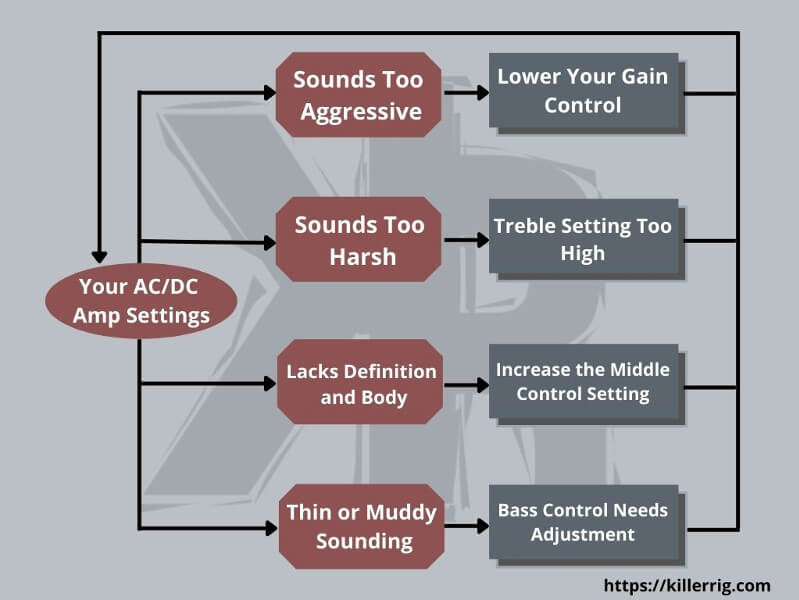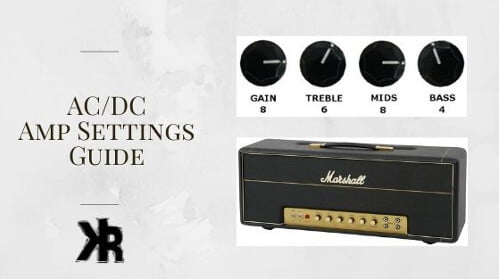Table of Contents
AC/DC is one of the most popular classic rock bands that still hugely impact music today. Angus Young and the band are most recognizable for their searing guitar tones and vocals.
Getting the same iconic tones can be difficult without the right equipment. Plus the right AC/DC amp settings.
In this Killer Rig guide, we’ll give you the rundown of what amps and settings were used by Malcolm and Angus Young. This way, you can dial in those tones yourself.
What is The AC/DC Sound?
There are a variety of old-school sounds and styles within AC/DC’s discography. There is one thing that all their songs have in common. They’re loud!
AC/DC amps are set to the highest volumes possible, so you can feel the power of their music. This isn’t just something that happens at concerts, either. Even their studio recordings are designed to be cranked up loud.
This provides that Marshall amp tube distortion that classic rockers are known for. Especially Malcolm Young and AC/DC.
Some Quick amp settings to sound like AC/DC are:
- Gain: 7
- Treble: 6
- Middle: 5
- Bass: 6
- Presence: 5
This will allow you to get a good classic crunch tone that will emulate their sound. All without having to blast your volume control to the maximum.
Not sure what amp settings actually do? Check out my guide to amp controls and settings to get up to speed!
AC/DC Amp Settings
Once you have the right gear, it’s important to know how to use your amp settings to shape your sound.

Gain Control
The gain setting on your amplifier will be one of the most important for getting an AC/DC sound.
You’ll want to set this to around 7-9 to get a good amount of distortion without making your sound too muddy. If your amplifier gets uncontrollable at this level, turn it down until it clears up.
Your sound cannot be too heavy in the bass response, so add as much gain as you can before it loses clarity. It’s also worth mentioning that sometimes this control is labeled as drive. It can vary between amp manufacturers and models.
Get the best Randy Rhoads amp settings here!
Equalization
The EQ section of your amplifier will then need to be adjusted once you have your gain level set. Begin by setting all controls to halfway, and then adjust them to what you would like to hear.
- The treble knob will need to be adjusted to be quite bright without any harshness. If your guitar is warmer sounding, then you will need higher levels of brightness.
- The middle control is used to add thickness and body to your tone. The guitar is a mid-focused instrument. So higher levels will provide great classic crunch sounds.
- When adjusting the bass control, make sure to keep it punchy. Adjust it without the low-end being overwhelming. Too much bass can ruin a good crunch tone in a hurry.
If you have a presence or depth knob on your amplifier, set them to halfway as well. These controls should be set after your main EQ is adjusted. This way you can fine-tune the response without drastically affecting your tone.
The presence control will support all treble frequencies. While the depth knob will add more thump to the bass.
Popular AC/DC Songs And Their Amp Settings
Once you understand how the controls affect your sound, it’s time to look at some popular songs. As well as how the amp settings have shaped their tone.
Back In Black
The opening riff to Back in Black is one of the most recognizable in all of rock music. It’s also a great example of an AC/DC sound that can be achieved with the right amp settings.
The amp settings for this song are:
- Gain: 6-7
- Treble: 6
- Mids: 6
- Bass: 5
- Presence: 6
If you can crank your volume up, use less gain and try to rely on your power section to provide some distortion. This can be another way to get a great crunch sound, especially with EL34 power tubes.
Check out our Led Zeppelin amp settings here.
Highway To Hell
Another great AC/DC song for understanding their tone and amp settings is Highway to Hell.
The main riff on this song uses a lot of midrange frequencies to get an aggressive sound. It’s far more crunchy and has a thicker tone. To mimic the amp settings for this song, use:
- Gain: 7-8
- Treble: 6
- Mids: 7
- Bass: 5
- Presence: 5
A good boost pedal can help shape the response. This will keep your sound thick and aggressive without overwhelming bass.
Thunderstruck
Another incredibly recognizable song by AC/DC is Thunderstruck. This opening lick is known by most classic rockers, especially those who have tried to learn it.
The amp settings for this song are similar to Back in Black, but with a bit more gain and fewer mids. To get the Thunderstruck tone, use:
- Gain: 7-8
- Treble: 7
- Mids: 5-6
- Bass: 5
- Presence: 6
Hell’s Bells
Another legendary intro riff comes from the song Hell’s Bells. This is another great example of how to get a thick and aggressive sound. And without sacrificing clarity.
To get a good Hell’s Bells sound, use these amp settings:
- Gain: 7-8
- Treble: 6
- Mids: 6
- Bass: 5
- Presence: 5
Depending on your amplifier, these settings may need to be adjusted. Every guitar and amp are different, so adjust yours until you get the tone you need.
What Gear Do You Need For An AC/DC Sound?
To get the trademark AC/DC amp tone, you’ll need to have some specific gear.
- One of the most essential parts is a Marshall or equivalent British-style amplifier. The Young brothers both used cranked Marshall heads with EL34 tubes to get their tone. Your amp doesn’t have to be a head, a good combo will work great too.
- A boost pedal can also be used to push your sound into Angus mode. This can be great for getting a better heavy crunch from some amplifiers.
- Finally, you’ll need a Gibson SG guitar or similar. Angus Young has used this guitar exclusively throughout his career. So it’s an essential part of getting that AC/DC sound.
Once you have AC/DC figured out, get Slash’s amp settings here!
Tone Trouble Shooting Tips
If you are having some issues trying to get a good AC/DC sound, there are a few things to consider.
- A guitar with humbucker pickups will be best if you are trying to get an Angus Young sound. While it was somewhat bright, it was also warm.
- If your amplifier is too aggressive, turn down the gain until it produces a good classic rock crunch. If you have multiple channels, choose the one that does a good AC/DC tone.
- When your sound is too thin and bright, try adding some mid-range to your tone. This can help thicken it up. You might also try to use your tone control on the guitar to warm it up.
- Sometimes the bass can become overwhelming and muddy. When this happens, try turning down the bass control. If this doesn’t help, then your gain might be too high. Try turning it down until it becomes clear.
- Not able to produce a good classic rock sound with your amplifier? Maybe some good distortion pedals can help. Try using one into a clean amp to get a great overdrive tone.
Learn how to set your amp for rock tones here.

Conclusion
Whether you are a huge AC/DC fan or just love classic rock tones. It’s easy to get those great sounds with the right amp settings.
Learning how to set your amp for the sound you want can take some experimentation. But once you find that sweet spot, you will be amazed by all the different tones available.
Remember to keep your gain and volume up to get a good crunch, but adjust them as necessary for different songs.
FAQs
What amps does AC/DC use?
Angus Young of AC/DC is known for using Marshall amps, specifically the JTM45. This amplifier was used on most of their early albums.
The Wizard vintage modern 100-watt amplifier was also used. But closer to the later part of their career.
What is the best guitar for getting an AC/DC sound?
There is no definitive answer to this question, as it depends on personal preference. Angus Young typically used the Gibson SG and other guitars. But with humbucker pickups.
These have a warmer sound that works well for classic rock tones. Single coil pickup guitars produce brighter tones and might not be best suited for an AC/DC style.

